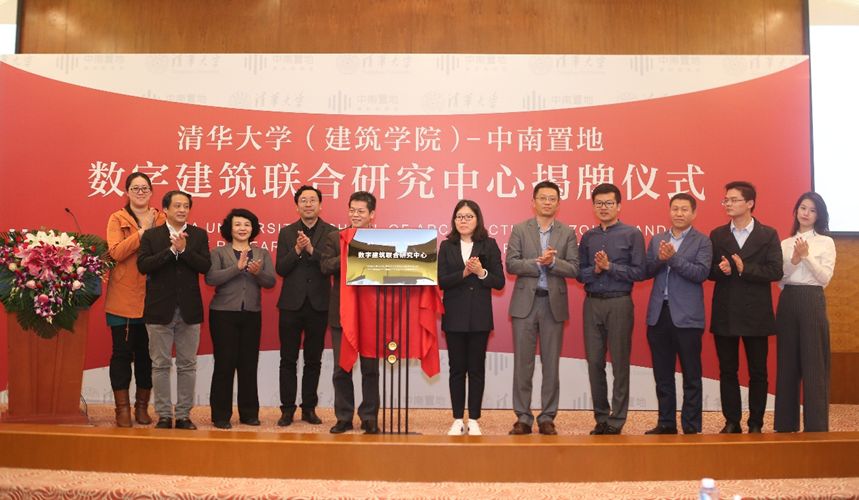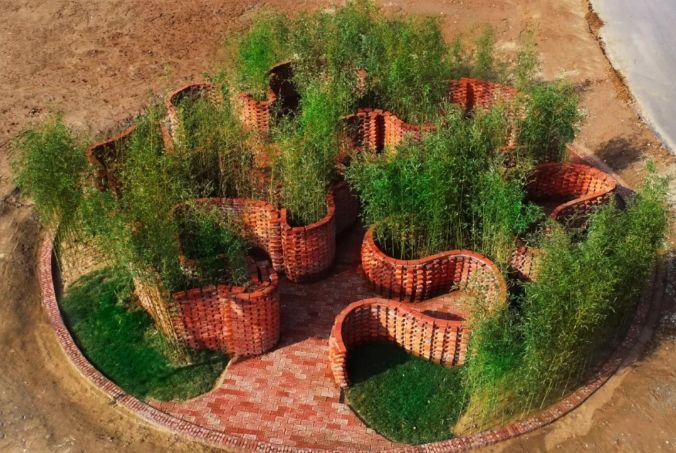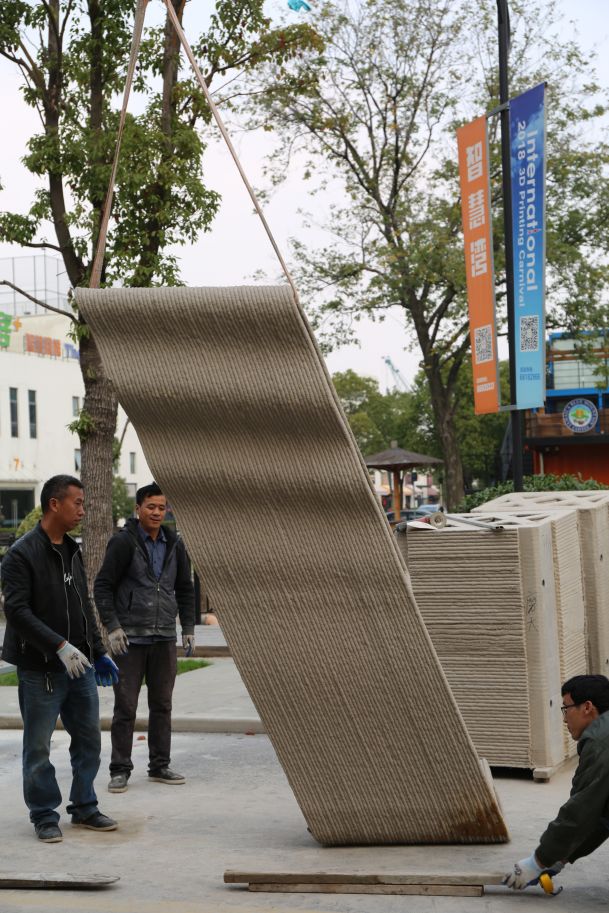Author: Gu Wangwu
On January 12, the world’s largest concrete 3D printed pedestrian bridge was completed in Shanghai’s Baoshan Smart Bay. This bridge was designed and developed by Professor Xu Weiguo’s team from Tsinghua University (School of Architecture) and Zhongnan Land.
The bridge is 26.3 meters long and 3.6 meters wide, utilizing a single-arch structure inspired by the ancient Chinese Zhaozhou Bridge to bear loads, with an arch foot spacing of 14.4 meters. Its scale far exceeds the two previously completed concrete 3D printed bridges in the Netherlands and Spain.

The image shows the pedestrian bridge filled with people.

The Future is Here: Behind the Scenes of the 3D Bridge Completion
This pedestrian bridge features three-dimensional solid modeling, with the bridge railing designed in a ribbon-like shape, creating a light and elegant form together with the arch. Additionally, the bridge deck adopts a brain coral shape, with gaps filled with fine gravel to form a landscaped surface.

The image shows the surface of the concrete 3D printed pedestrian bridge.
Before actual printing construction began, a 1:4 scale material bridge destruction test was conducted, confirming that its strength meets the load requirements for full occupancy.
The printing material for the components is a composite material made of polyethylene fiber concrete with various additives, which has undergone multiple ratio tests and printing experiments, achieving controllable rheology to meet printing needs. The new concrete material has a compressive strength of 65 MPa and a flexural strength of 15 MPa.

The image shows the concrete 3D printer printing the bridge deck.
It is reported that many research institutions and construction companies both domestically and internationally have been dedicated to technological breakthroughs in 3D concrete printing, but this technology has not yet been truly applied in actual engineering. The completion of this pedestrian bridge marks a significant step from research and development to practical engineering application, indicating that China’s 3D concrete printing construction technology has reached a world-leading level.
Notably, the entire bridge project was printed using a dual robotic arm 3D printing system, taking a total of 450 hours to complete all concrete components. Compared to bridges of similar scale, its cost is only two-thirds that of conventional bridges, and the main body of the bridge was printed and constructed without the use of molds or steel reinforcement, significantly reducing project costs.

Innovation as the Source: Breaking Through the Bottleneck of 3D Printing Technology
The collaborative research and development plan between Zhongnan Land and Tsinghua University began in 2017.
Zhongnan Land stated that when formulating healthy housing standards, they recognized the significant impact of digital technology on the future development of architecture. Based on this shared understanding and a sense of mission for industry development, Zhongnan Land and Tsinghua University’s School of Architecture jointly established the “Digital Architecture Joint Research Center” to provide research support for industrial upgrades and to address changes in social labor force.

The image shows the unveiling of the joint research center between Tsinghua University (School of Architecture) and Zhongnan Land.
It is reported that over the course of more than a year, the research center’s projects have included concrete printing, digital design, intelligent construction, robotic arms, BIM reverse modeling, virtual reality technology, spatiotemporal behavior big data, and interactive architecture, all closely related to community construction, and have independently developed new materials and equipment, achieving several results. This 3D printed pedestrian bridge is one of the significant achievements.
In the area of robotic arm-related projects, the research center has successfully achieved collaborative printing with robotic arms, creating spatial curved forms and breaking the structural limitations of straight lines and right angles characteristic of the reinforced concrete era.

The image shows one of the research achievements, the “Brick Maze Garden”.
The “Tsinghua University (School of Architecture) – Zhongnan Land Digital Architecture Research Center” has also innovatively invented the “Robotic Arm Automatic Bricklaying System,” which, unlike existing bricklaying systems domestically and internationally, combines robotic arm automatic bricklaying with 3D printed mortar for the first time, forming a fully automated integrated intelligent construction system; and has been the first in the world to apply this system in actual construction sites, building a “Brick Maze Garden.”

The image shows one of the research achievements, an outdoor landscape seat.
Zhongnan Land stated that there are currently 3D printed seats in use in the landscaping of their Xi’an project. These seats are aesthetically pleasing, of high quality, and can be constructed very quickly. In the future, as these research achievements mature, they will gradually be applied to Zhongnan Land’s project construction, enhancing the intelligence and technological level of building construction. The expectation is to be able to 3D print concrete houses with free structures.

Focusing on R&D: Opening a New Era of Intelligent Construction
As China’s demographic dividend fades, the demand for labor in construction projects will increasingly exceed supply, and intelligent construction will be an important channel to address this issue. It will promote the transformation and upgrading of China’s construction industry, with 3D printing playing a significant role in the intelligent development of engineering construction.

The image shows the installation of the concrete 3D printed bridge railing.
Zhongnan Land stated that this is precisely their original intention in investing in the R&D of 3D printing technology. In the future, Zhongnan Land will leverage its years of industry experience, together with the Tsinghua University (School of Architecture) – Zhongnan Land Digital Architecture Research Center, to once again set a benchmark for the Chinese real estate industry with technology and open a new era of intelligent construction for the traditional real estate sector.
Yan Yuejin, director of the Shanghai E-House Real Estate Research Institute, pointed out that under the current model of “housing is for living, not for speculation,” such technological innovations are very valuable. In recent years, traditional real estate has often measured success solely by fluctuations in housing prices. However, as housing increasingly returns to its attributes and functions for living, the application of these innovative technologies will become more widespread in the future, especially in areas such as affordable housing, public rental housing, and ordinary commercial rental housing. Such technological applications will be extensive and serve as a good guide for the supply side of real estate.